

[Summary] [Details of Contraceptive Story] [7 Gems patent medicine] [Nellie Ferguson]
[Otto Sandt] [Glass Bottles] [Lapel Pin, Etc.] [Catholic Pamphlets] [Bits & Scraps]
I removed an old brick chimney to make way for a laundry chute in my 116 year old frame house in the summer of 2008. I discovered a dead spot behind where the chimney used to be, above a closet. The closet has a ceiling about 7' up, creating a space above that, but below the attic floor. Among other things, I discovered a handbill printed in 1892 that was an advertisement for an “agency business” (salesmen kits) for selling contraceptive rubber diaphragms door to door.
Here’s the handbill front and back (click images to embiggen):
The handbill is great reading, but I really didnít know what the product was until I located a single example of the coupon. Click image to embiggen:
So the first occupant of my house (built in 1891-2) was selling these salesman kits and filling orders for some kind of one-size-fits-all contraceptive diaphragm in Victorian Era St. Louis.
In 1873, the U.S. passed the Comstock Law which was a sweeping anti-indecency laws which prohibited the manufacture, sale, distribution and use of contraceptives. It also declared any printed matter about contraceptives to be obscene and prohibited its sale or shipping via the Post Office.
The Comstock Laws remained in effect until 1939.
Susan Jacoby’s history of secularism has several pages about the Comstock Laws (and the demented, dirty-minded Anthony Comstock). These laws were also used to repress the dissemination of Free Thought publications. Comstock hounded congressmen to pass his bill. What was considered “obscene” was left mostly to Comstock’s individual judgement as Inspector General.
Also, on the history of contraceptives:
1844
Charles Goodyear patents vulcanization of rubber. Soon, rubber condoms are mass produced. Unlike modern condoms -- made to be used once and thrown away -- early condoms were washed, anointed with petroleum jelly, and put away in special wooden boxes for later reuse. British playwright and essayist George Bernard Shaw called the rubber condom the “greatest invention of the nineteenth century.”1844-1873
The U.S. contraceptive industry flourishes. In addition to condoms (immediately known as “rubbers”), there’s widespread sale and use of intrauterine devices or IUDs, douching syringes, vaginal sponges, diaphragms and cervical caps (then called “womb veils”), and “male caps” that covered only the tip of the penis.1873
The U.S. Congress passes the Comstock laws. Written by dry goods merchant and anti-obscenity crusader Anthony Comstock, the law makes all forms of contraception illegal. The contraceptive industry continues to flourish — but the devices are now sold to promote “feminine hygiene.”1880s
Penniless New York City immigrant Julius Schmid gets extra sausage casings from butcher shops and makes them into skin condoms. It becomes a big business by 1890. By the 1930s, his condom empire is making millions. His Ramses and Sheik brands are still popular.1898
Nineteen-year-old Margaret Sanger’s mother dies at age 50, exhausted from giving birth to 11 children. Sanger becomes a nurse and aids survivors of botched abortions. Later she turns her attention to the development of better contraceptives. Her dream: A birth control pill.
In my search to learn more about the history of contraceptives, I found a delightful and fascinating book: Devices & Desires, A History of Contraceptives in America by Andrea Tone. From the information in this book, I was able to know for sure (from the language on the coupon) that the product was a one-size-fits-all diaphragm. Further, I’m reasonably sure I know who the manufacturer was. From this book:
One early entrepreneur was Edward Bliss Foote, a medical college graduate who believed in the then-radical notion that women should control their reproduction. Mr. Foote made a one-size-fits-all womb veil in the 1860’s and sold it for $6 at clinics and through mail order.
That $6 price is similar to the $5 retail my guy says to compare to. (He sells them for basically $2 each to the customer. One dollar goes to the salesman and one dollar goes to my address. He also makes a bit of money off the salesmen for the price of their “outfits”.) In the handbill, though, he claims he’s willing to share his profit like this because he will get the repeat business, done directly by mail rather than through the “agent”.
Edward Bliss Foote is also my kind of person. He was a physician who took on the Comstock Laws. In addition to being a proponent of women’s reproductive rights, he was also a supporter of Susan B. Anthony and women’s suffrage, a Free-Thinker, and a strong opponent of the Comstock Laws.
And further:
Foote was a member of the Federation of Freethought, the Secular Union, the Manhattan Liberal Club, the Institute of Heredity, and the Constitutional Liberty League. His son Edward Bond Foote also became a physician and freethinker.
Another interesting point that became clear reading Tone’s book: many early supporters of women’s reproductive rights preferred diaphragms and similar devices over condoms because they put reproductive control in the hands of women.
I contacted Dr. Tone to ask for any advice. I was hoping as a long shot that maybe there was some record of customers or distributors of Edward Bliss Foote’s diaphragms. No such records exist (the business was illegal!), but Dr. Tone offered some other advice to find out more about the occupant of my house. She also indicated that if PBS’ History Detectives decided to take up my story, she would be willing and able to fly out there to be an expert on the topic, since she has grant money to cover this sort of thing.
The handbills especially are extremely fragile. The coupon was partly burnt, wrinkled, and covered in dirt and soot. I had a sample of each cleaned and lined (two handbills, one showing the front, one showing the back, and the coupon) by Richard C. Baker, a professional paper conservator. The images of the flyer and coupon on this page are after his cleaning and mounting them.
[Return to Top of Page]In March, 2009 (6 or 7 months after the original discovery), I found another part to the story. I was pulling up the floor boards in the attic to shop vac out 116 years worth of dust and debris when I found a fragment of a paper box with a fragment of an insert and a tiny glass vial with a cork stopper.
Best I can tell, the same entrepreneur was also running an “agency business” selling a patent medicine. I think this kit was a salesman’s sample. The vial is too small to be more than a single dose of whatever this is. Also the text on the box is primarily directed to potential agents.
Here’s what the box and vial look like (click images to embiggen):
To the naked eye, the printing on the box is almost completely illegible. By scanning the box and then playing with contrast, hue, saturation, etc. settings in Photoshop, I was able to read almost all the text that’s there.
First, here’s a sample of the modified scan that let me make out the text (click image to embiggen):
Here is the complete text from the box (preserving line breaks and case):
And finally, here is the insert fragment more or less reassembled (click image to embiggen):
I haven’t been able to find out anything about 7 Gems patent medicine. I suspect it was something that was made up completely from scratch here in my house.
On this stuff, my addresses is given as the address of the Spanish Herb Company. In the diaphragm business, my address (with an "A") was given as the address of Crestol Manufacturing Company.
Many of the distinctive typefaces in the contraceptive handbill appear on the box and insert, so I’m certain it is the same person. I also investigated those typefaces, and the most dramatic of them (see the handbill) were created not long before 1892.
[Return to Top of Page]By searching through the Recorder of Deeds records at City Hall, I’m pretty sure I know who the entrepreneur was.
The first time I went to City Hall, I learned how to trace the transfer of deed backwards from the present in the books and microfilm records there. When I reached a certain point, I hit a bit of a dead end. In the 1920s, the house went through Probate Court to transfer one by one to a bunch of people from the Hermann family. (From the look of it, they each used this little house as a starter house when they got married.) It seems when the patriarch of that family, Moses Herman, died in 1919, his will gave the house to his wife AND all his kids AND a couple of his siblings. So they each had a 1/12 share or something like that. Several sold their shares immediately.
I got passed this barrier the second time I went there and found where the P.C. records were.
The house was first owned by William O. Croswhite and his wife (no first name given). I think Croswhite was the builder, though. He sold it, along with 4 other houses in the area to the Metropolitan Real Estate Company in 1891 (for a total price of $17,180).
May 9, 1891, Metropolitan R.E. sold it to William H. Shea (and his wife Mary A. Shea). Shea was a real estate agent (see below) and never lived there. The price was $489.00.
Shea sold it to the first occupants of the house on September 15, 1891: Nellie Ferguson, wife of Edward H. Ferguson. (Very odd—usually properties go to the man’s name, and the wife is listed below his name with the phrase “his wife”.) Nellie bought the place for $1300.
Strangely enough, though, Nellie Ferguson sold it back to Shea less than a year later (June 6, 1892) for $1.00. But I know the Fergusons still lived there after that (see below).
I went to the Missouri Historical Society archives and research center on Skinker near Wydown. I donated the extra copies of the handbill to them, since I’m sure they wouldn’t survive long in my possession.
I was able to confirm that Nellie and Edward Ferguson were indeed the first occupants of the house, and they lived here in 1892 and 1893 (after Nellie sold the house back to Shea). I confirmed this by using the Gould’s St. Louis Directories. (These are like phone directories but before telephones were common.) Nellie’s name didn’t appear anywhere, but Edward appeared in the 1892 and 1893 editions at my address. In 1892 & 1893, his occupation was listed as “painter” (same as in the recorder of deeds). In the 1894 edition, his address was listed as 2319 Papin, and his occupation was listed as “laborer ”.
Also, William Shea was listed in the Directories as a Real Estate agent. His office was on Chestnut (and later Olive) downtown, but he lived on Lee Ave. He never lived in my house, as I suspected. I assume Shea financed their mortgage, and selling it back for $1 was a sort of foreclosure. Since they lived there in 1893, I imagine they rented. (Either that or the 1893 directory listing wasn’t updated.)
After that, I appealed to various on-line geneology sites devoted to the name Ferguson for help. Colin Ferguson (not a descendant of Nellie and Edward) helped me out. He located Nellie & Edward’s 1900 Census record. In 1900, they were still married, and still lived in the “Tower Grove area,” but they were renting an apartment. According to their listing, they had been married 17 years, meaning they were married in 1873. Edward was born in Illinois in May of 1862. Nellie was born in Minnesota in March of 1863. They were in the early 30s and married just under 20 years when they lived in my house.
Edward’s father was born in Illinois, and his mother was born in Arkansas. Nellie’s father was born in Pennsylvania, and her mother was born in Mississippi. (I still have no maiden name for Nellie.)
As of 1900, Nellie had given birth to 5 children, but only 2 survived: Pete, born in 1892 and John born in 1895. So Pete would have been born when they lived in my house.
Edward was listed as a painter on the Census form, and both he and Nellie could read, write and speak English.
They’re listed as family number 117 on this page.
Colin also found down the death record of John Ferguson (died in Florida in December of 1980). I’ve got his SSN, and can use that to get the Social Security application which should tell me more about the family. Hopefully, I’ll locate some surviving descendants.
[Return to Top of Page]In the same dead space where I found the handbills, I found dozens of business cards of a decorator/painter named Otto Sandt.
I found some other documents including a letter from the Construction Industry Credit Bureau that tells me Sandt lived here somewhere around 1933. Actually, the address on the cards and on the letter are both in South St. Louis, but neither document has my address. Poor guy. I can imagine a painter in hard times having to move often and struggling with debt when there’s no work. This would’ve been the worst part of the Depression —banks failed in ’33 following the second big stock market crash in ’32. FDR’s “bank holiday” happened in 1933.
[Return to Top of Page]The bottles merit their own page. Click here.
[Return to Top of Page]Under a floor board in the attic, I found a small lapel pin. At first, I thought it was a Knights of Columbus pin, since the logo looks so similar. The only text on it is D.R.K.C.V. and 1855. The logo is a sword, cross and goblet. It appears to be enameled brass, and it's about the size of a penny. The blue is a very dark navy blue. The text is actually a very dark blue and not black. (The colors on these pix are terrible.)


The initials stand for Deutscher römisch-katholischer Centralverein, that is, the German Roman Catholic Central Union. It was an organization founded in Buffalo, NY in response to anti-Catholic sentiments at the time.
I think the pin dates from between 1900 and about 1935, most likely the later part of that range. I read somewhere that this style of pin clasp is from about the turn of the century. I think someone from the Moses Herman family was probably the person in my house that owned the pin.
Among the bits and scraps of paper, I found a ticket stub in German from a New Year's Eve Celebration at the German Dramatic Club from December 31, 1932.

Found: May 3, 2010
On top of the large cold air return to the furnace, under a thick coating of dust I found a metal cap from a container that once held a bottle opener and five Catholic pamphlets.
The metal thing is about 2" diameter, made of ferrous metal (very rusty), and looks sort of like a hub cap. Printed on it are the words:
OPENand the image of an arm and hand using a bottle opener on a tin can with a glass jar behind it. It’s very rusty and difficult to see. Also my camera doesn't have a good macro setting, so here's the only image I have:
the
ANCHOR OPENER
ANY ??CK [possibly "neck"?]
BOTTLE
OPENER
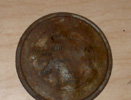
More interesting, and in much better condition are the Catholic pamphlets. Each one is about 3.5" x 6" and about 40 pages of very fine print text. They were all printed by The Queen's Work at an address in or near St. Louis University, and all but one was authored by a Jesuit (and that one by priest). They have copyright dates ranging from 1937 to 1947.
Here are the covers of all 5 and the inside back cover of the "Prayers Are Always Answered" one:
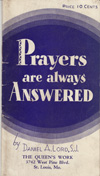 | 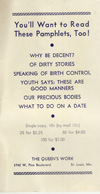 | 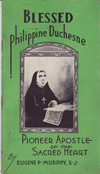 |
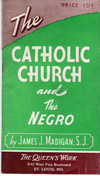 | 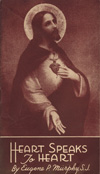 |  |
As always, click on any of the thumbnails to embiggen the image.
[Return to Top of Page]I also found a bunch of other items and scraps of paper in the dead space and elsewhere. I’ll eventually post a mini catalogue of that stuff here.
[Return to Top of Page]